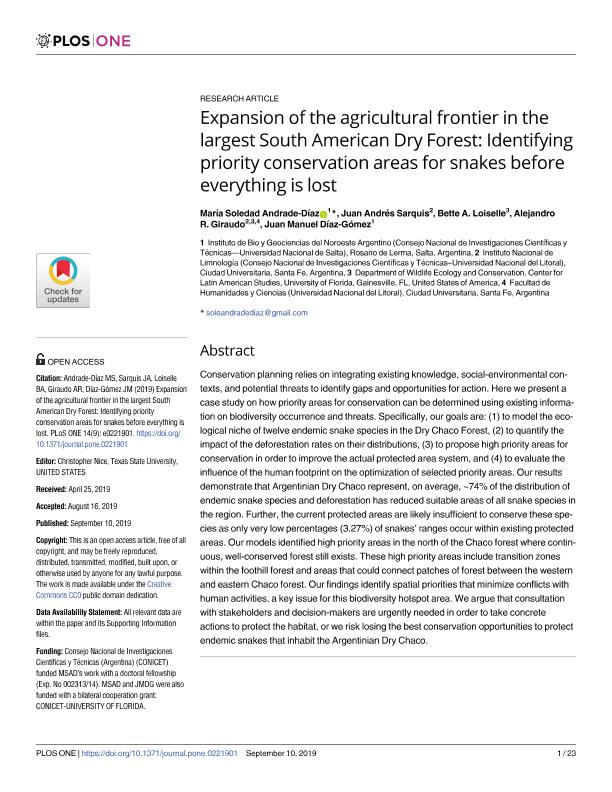Artículo
Expansion of the agricultural frontier in the largest South American Dry Forest: Identifying priority conservation areas for snakes before everything is lost
Andrade Díaz, Soledad María ; Sarquis, Juan Andrés
; Sarquis, Juan Andrés ; Loiselle, Bette A.; Giraudo, Alejandro Raul
; Loiselle, Bette A.; Giraudo, Alejandro Raul ; Diaz Gomez, Juan Manuel
; Diaz Gomez, Juan Manuel
 ; Sarquis, Juan Andrés
; Sarquis, Juan Andrés ; Loiselle, Bette A.; Giraudo, Alejandro Raul
; Loiselle, Bette A.; Giraudo, Alejandro Raul ; Diaz Gomez, Juan Manuel
; Diaz Gomez, Juan Manuel
Fecha de publicación:
10/09/2019
Editorial:
Public Library of Science
Revista:
Plos One
ISSN:
1932-6203
Idioma:
Inglés
Tipo de recurso:
Artículo publicado
Clasificación temática:
Resumen
Conservation planning relies on integrating existing knowledge, social-environmental contexts, and potential threats to identify gaps and opportunities for action. Here we present a case study on how priority areas for conservation can be determined using existing information on biodiversity occurrence and threats. Specifically, our goals are: (1) to model the ecological niche of twelve endemic snake species in the Dry Chaco Forest, (2) to quantify the impact of the deforestation rates on their distributions, (3) to propose high priority areas for conservation in order to improve the actual protected area system, and (4) to evaluate the influence of the human footprint on the optimization of selected priority areas. Our results demonstrate that Argentinian Dry Chaco represent, on average, ~74% of the distribution of endemic snake species and deforestation has reduced suitable areas of all snake species in the region. Further, the current protected areas are likely insufficient to conserve these species as only very low percentages (3.27%) of snakes’ ranges occur within existing protected areas. Our models identified high priority areas in the north of the Chaco forest where continuous, well-conserved forest still exists. These high priority areas include transition zones within the foothill forest and areas that could connect patches of forest between the western and eastern Chaco forest. Our findings identify spatial priorities that minimize conflicts with human activities, a key issue for this biodiversity hotspot area. We argue that consultation with stakeholders and decision-makers are urgently needed in order to take concrete actions to protect the habitat, or we risk losing the best conservation opportunities to protect endemic snakes that inhabit the Argentinian Dry Chaco.
Archivos asociados
Licencia
Identificadores
Colecciones
Articulos(IBIGEO)
Articulos de INST.DE BIO Y GEOCIENCIAS DEL NOA
Articulos de INST.DE BIO Y GEOCIENCIAS DEL NOA
Citación
Andrade Díaz, Soledad María; Sarquis, Juan Andrés; Loiselle, Bette A.; Giraudo, Alejandro Raul; Diaz Gomez, Juan Manuel; Expansion of the agricultural frontier in the largest South American Dry Forest: Identifying priority conservation areas for snakes before everything is lost; Public Library of Science; Plos One; 14; 9; 10-9-2019; 1-23
Compartir
Altmétricas



